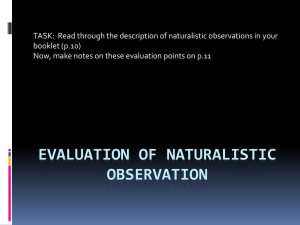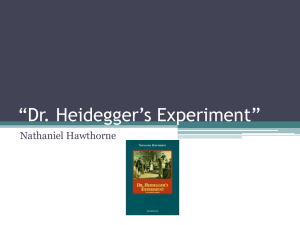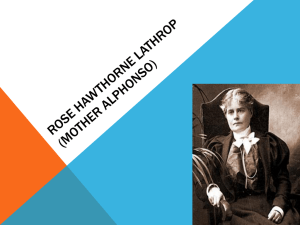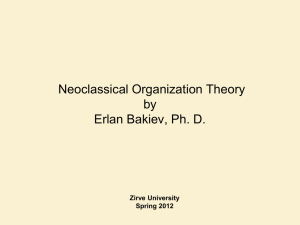1 - Idiotsguru
advertisement
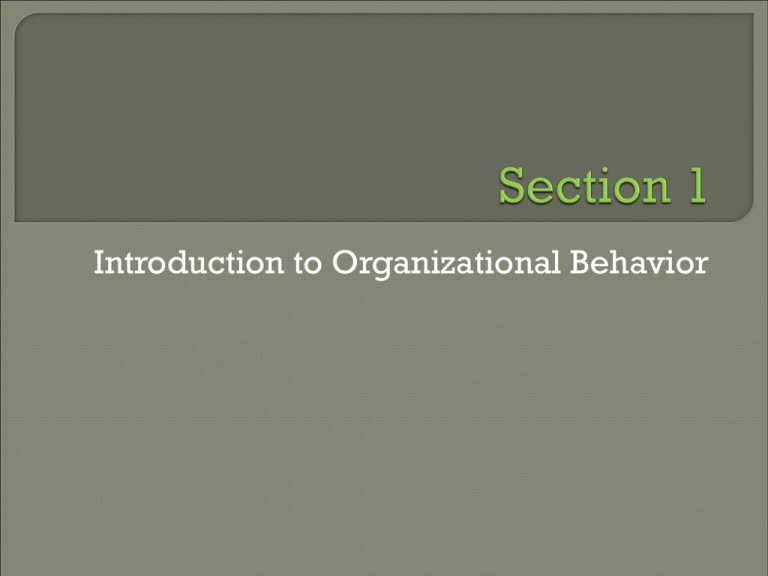
Introduction to Organizational Behavior Good to Great Jim Collins (2001) “Good is the enemy of great.” Provide an overview of the major challenges and the paradigm shift facing management now and in the next economy. Outline an organizational behavior perspective for today’s management. Summarize the Hawthorne studies as the starting point of modern organizational behavior. Explain the methodology that is used to accumulate knowledge and facilitate understanding of organizational behavior. Relate the various theoretical frameworks that serve as a foundation for a model of organizational behavior. What is Organizational Behavior Characteristics of Organizational Behavior Why study Organizational Behavior • The Human Equation • Challenges in Managing • The New Paradigm Hawthorne Studies and Research in O.B. Sumerians- Record Keeping Egyptians- Need for Planning and Control Moses- Shared Leadership, Delegation Hamurabi- First ______? Alexander the Great- Use of Staff Niccolo Machivelli- The ends _____ the ______. Groups of people who work interdependently toward some purpose • Structured patterns of interaction • Coordinated tasks • Work toward some purpose The study of individual behavior and group dynamics in organizations Understand Predict Manage (Continued) e.g., Selection Systems Organizational Level e.g., Groupthink Group Level e.g., Personality Individual Level Cognitive Framework • Personality • Satisfaction, Commitment and Absenteeism Model • Attraction- Selection-Attrition Model Behavioristic Framework • Pavlov’s Dogs • Environmental Contingencies Social Cognitive Framework • Allows for more complexities • More accepted framework What is Organizational Behavior Characteristics of Organizational Behavior Why study Organizational Behavior • The Human Equation • Challenges in Managing • The New Paradigm Hawthorne Studies and Research in O.B. x Contingency Variables y Task environment: Competitors Unions Regulatory agencies Clients Structure Inputs: Material Capital Human Task Technology People (Actors) Organizational Boundary Outputs: Products Services What is Organizational Behavior Characteristics of Organizational Behavior Why study Organizational Behavior • The Human Equation • Challenges in Managing • The New Paradigm Hawthorne Studies and Research in O.B. Competitive advantage of an organization today is represented by: • Human resource of an organization and how they • • • • are managed. Widely recognized ashuman capital, social capital and positive psychological capital. The academic field of organizational behavior has been around for at least the past thirty years. Problems facing managers of human organization have been around since the beginning of civilization. Political Legal Developments Developments International Developments Although the problems with human organizations and the solutions over the ages have not really changed that much, the emphasis and surrounding environmental context certainly have. This new environment is disruptive, discontinuous change. It represents a new paradigm, a new way of thinking about the workplace. Three challenges facing managers to day are: - Globalization and Information Technology - Diversity - Ethics A paradigm simply establishes the rules (written or unwritten), defines the boundaries, defines a way to understand reality, ways of thinking/framework, and tells one how to behave within the boundaries to be successful. For today’s and tomorrow’s organizations and management, there are new rules with different boundaries requiring new and different behaviors. E.g., Theory X won’t cut it in most U.S. economic cycles There is considerable resistance to change and why it is very difficult to move from the old management paradigm to the new. “One-eighth” situation—about oneeighth of today’s organizations believe it, do it, stick with it. “The Knowing-Doing Gap”—most managers know the value of the human factor and how to implement the approach to improve organizational performance, but still are not doing it. What is Organizational Behavior Characteristics of Organizational Behavior Why study Organizational Behavior • The Human Equation • Challenges in Managing • The New Paradigm Hawthorne O.B. Studies and Research in Formal Organization - the official, legitimate, and most visible part of the system Informal Organization - the unofficial and less visible part of the system Hawthorne Studies: studies conducted during the 1920’s and 1930’s that discovered the existence of the informal organization The Illumination Studies: A Serendipitous Discovery Subsequent Phases of the Hawthorne Studies Implications of the Hawthorne Studies THE HAWTHORNE EFFECT The Overall Scientific Perspective • Understand • Predict • Control Starting with Theory The Use of Research Designs • Case • Survey • Experiments The Validity of Studies • Internal • External Questions What is a paradigm? What are some areas than have influenced the study of Org Behavior? What are some concepts studied in Org Behavior? Why should a manager know about this domain of knowledge? Contrast formal versus informal organization What happened in the Hawthorne Studies? Why are they so important and what did we learn from them? Describe 3 challenges facing managers today; why are they considered “challenges”? Describe the 1/8th rule or the “KnowingDoing Gap” Practitioner-Scientist Pfeffer’s 13 Practices (also ppt) Research in Management AME

